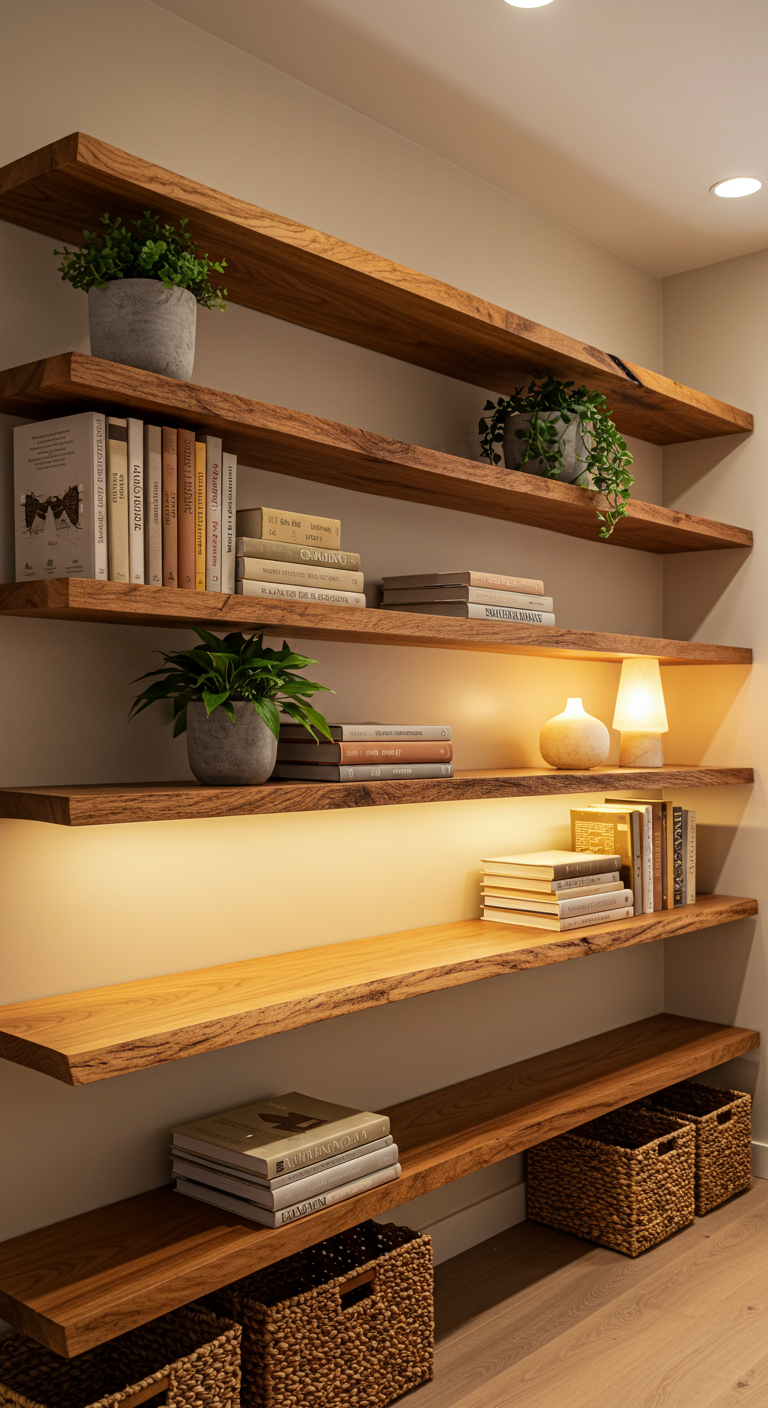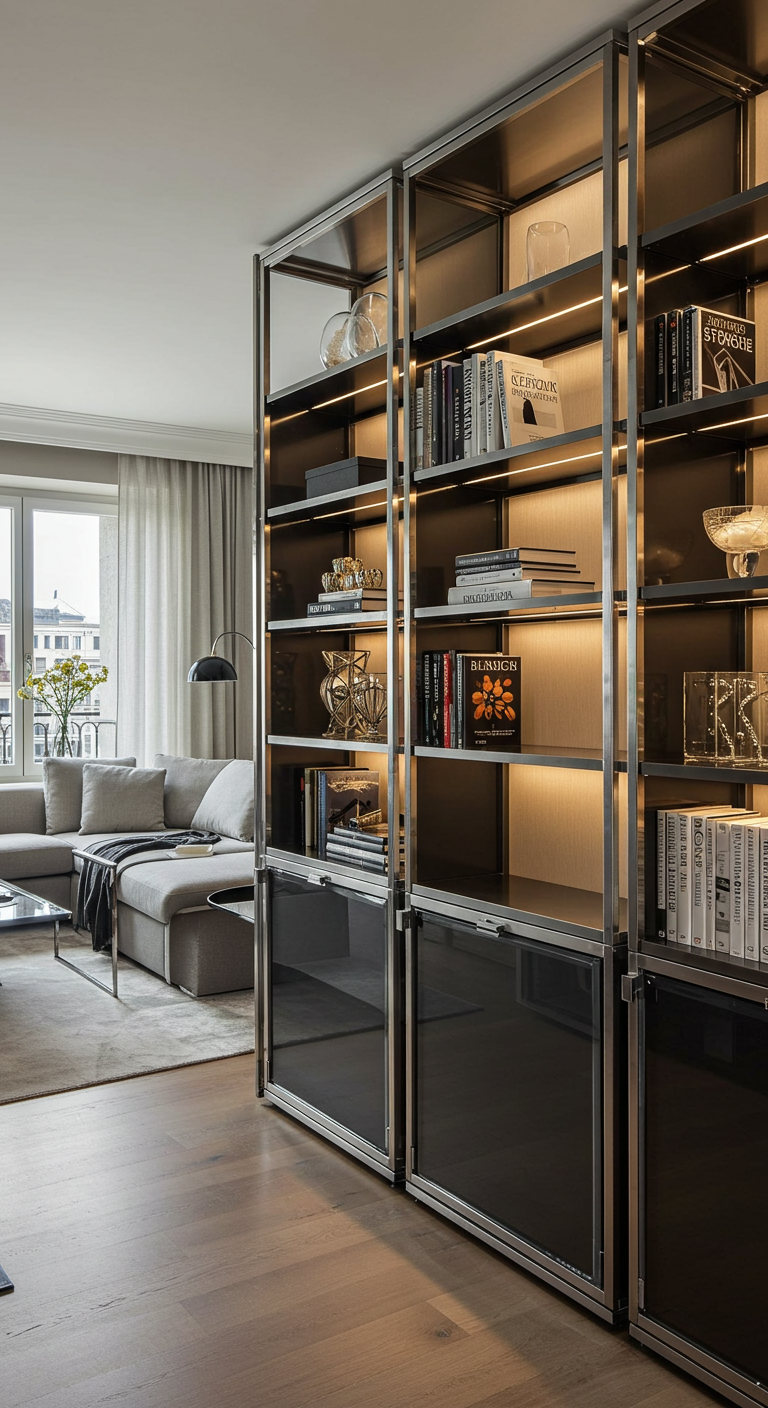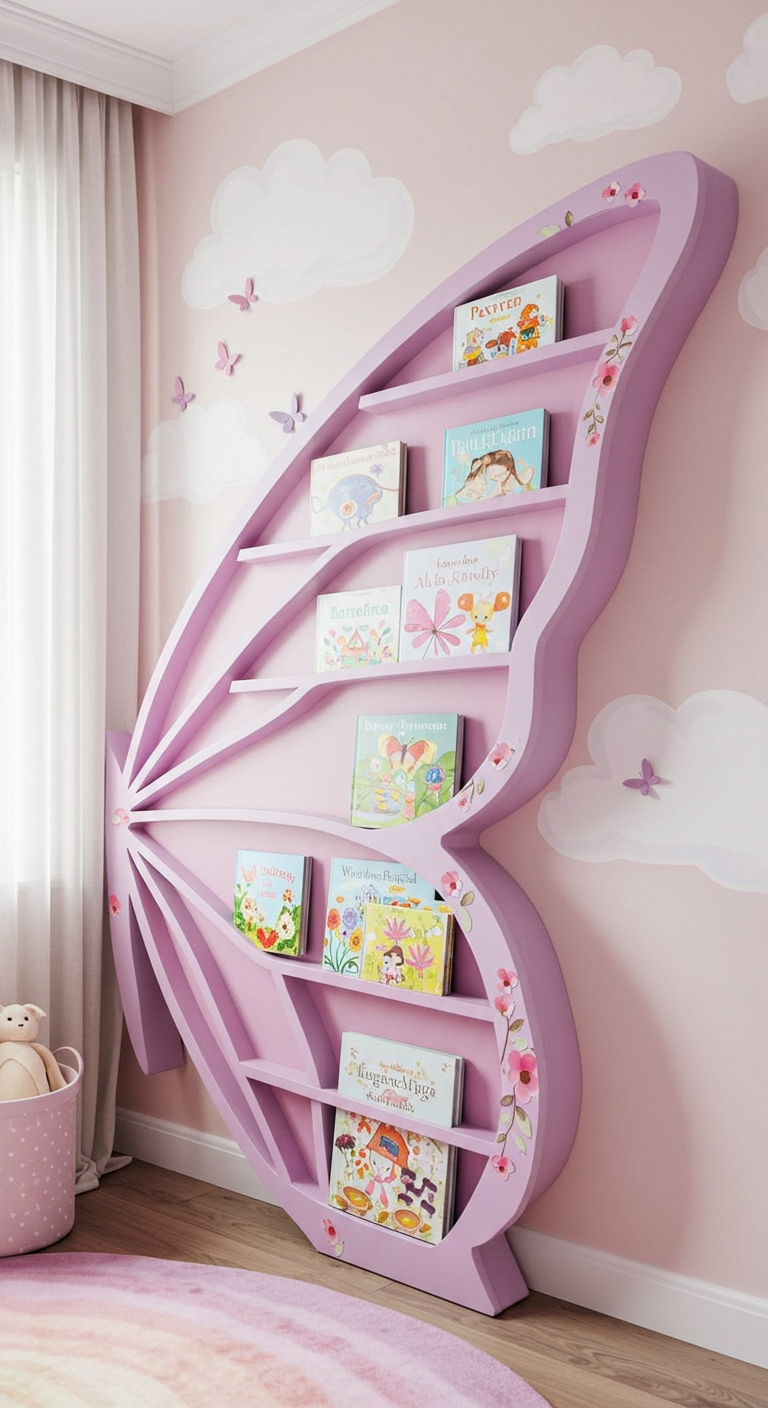15 Book Shelf Ideas Aesthetic Minimalist
15 Stunning Aesthetic Minimalist Bookshelf Ideas That Will Transform Your Space
Transform your home into a serene sanctuary with these carefully curated minimalist bookshelf designs that blend function with timeless beauty.
In a world filled with visual noise and clutter, there’s something deeply satisfying about the clean lines and purposeful design of minimalist bookshelves. These aren’t just storage solutions—they’re statement pieces that reflect a lifestyle choice toward intentional living and aesthetic harmony.
Whether you’re designing a cozy reading nook, organizing your home office, or creating a focal point in your living room, the right bookshelf can elevate your entire space. Minimalist design doesn’t mean boring or empty; it means every element serves a purpose while contributing to an overall sense of calm and sophistication.
The beauty of aesthetic minimalism lies in its ability to make even the smallest spaces feel open, organized, and effortlessly elegant. From floating shelves that seem to defy gravity to ladder-style bookcases that add architectural interest, these 15 ideas will help you create a bookshelf that’s both functional and Instagram-worthy.
Let’s explore how to curate a collection that speaks to your soul while maintaining that coveted minimalist aesthetic that Pinterest users absolutely love.
1. Floating Cloud Shelves
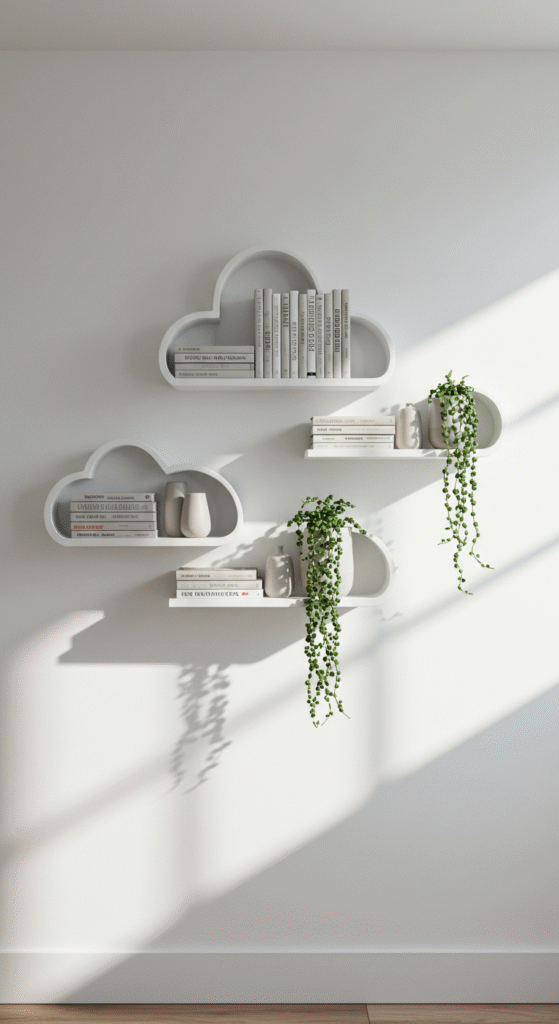
Transform your wall into a dreamy landscape with asymmetrically placed white floating shelves that appear to drift like clouds across your space. This design creates visual movement while maintaining the clean simplicity that defines minimalist aesthetics.
The key to mastering this look is strategic placement—vary the heights and distances between shelves to create an organic, flowing pattern. Choose shelves in crisp white or warm wood tones, and style them with a carefully curated selection of books in neutral covers, interspersed with small sculptural objects or trailing plants.
This approach works beautifully in bedrooms, living rooms, or home offices where you want to add storage without overwhelming the space. The “floating” effect makes rooms feel larger and more open, while the cloud-like arrangement adds a touch of whimsy to your minimalist design.
2. Monochromatic Ladder Bookcase
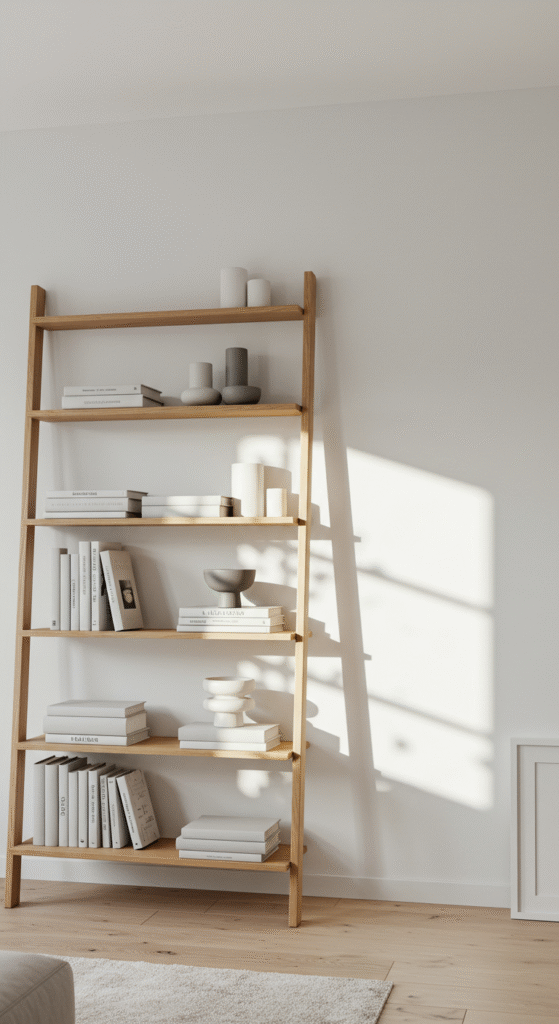
The ladder bookcase brings architectural elegance to minimalist spaces with its distinctive angled silhouette and open design. Choose a sleek wooden or metal ladder-style bookcase in a single color that complements your room’s palette—whether that’s warm oak, matte black, or crisp white.
Style each “rung” thoughtfully, alternating between stacked books, decorative objects, and negative space. The beauty of this design lies in its vertical emphasis, which draws the eye upward and makes ceilings appear higher. The angled sides create interesting shadows and add geometric interest without overwhelming the space.
This style works exceptionally well in small apartments or narrow spaces where traditional bookcases might feel too bulky. The open back allows light to flow through, maintaining the airy feeling essential to minimalist design.
3. Gallery Wall Book Display
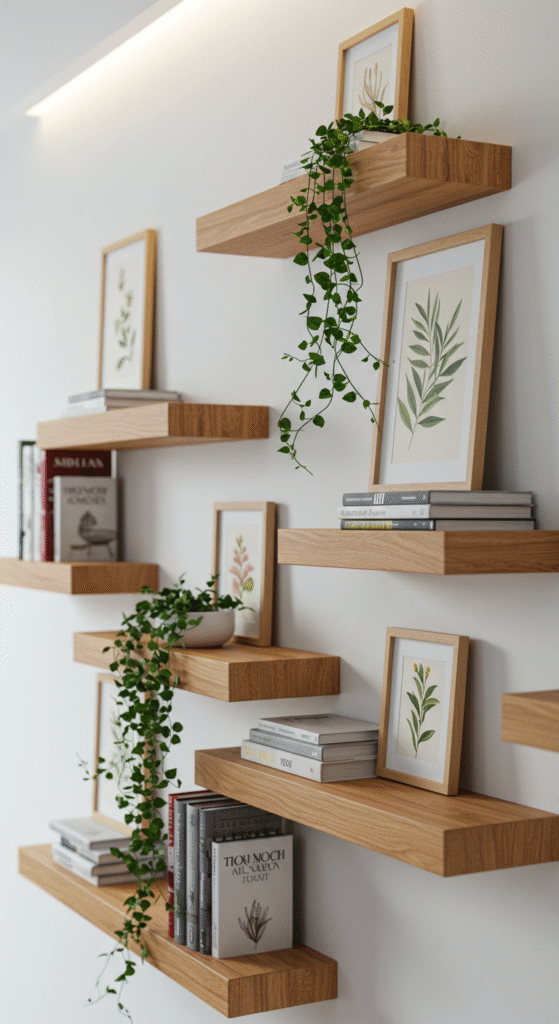
Reimagine the traditional bookshelf by creating a sophisticated gallery wall that combines floating shelves at various heights with framed artwork and plants. This approach treats your books as part of a larger artistic composition rather than simply storage.
Select 3-5 floating shelves in identical finishes but vary their lengths to create visual rhythm. Position them at different heights, leaving space between each for small framed prints or hanging plants. The key is maintaining consistent spacing and alignment to preserve the minimalist aesthetic while creating something uniquely personal.
Style with books turned spine-in for a cohesive color story, add small framed botanical prints, and incorporate trailing plants like pothos or string of pearls for organic texture. This design approach works beautifully above a desk, sofa, or in a hallway where you want to create visual interest without overwhelming the space.
4. Scandinavian Corner Sanctuary
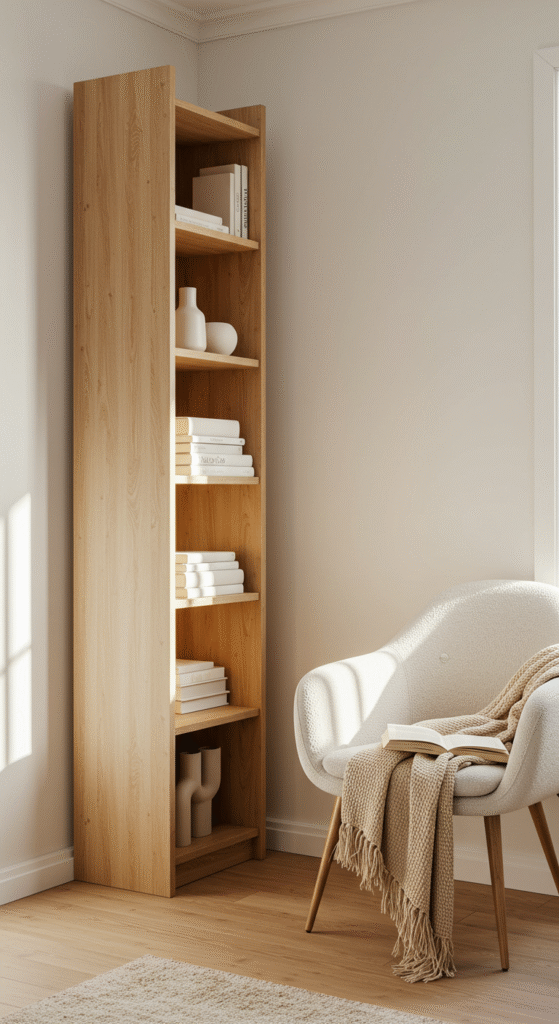
Create a peaceful reading corner with a tall, narrow bookcase that maximizes vertical space while maintaining the clean, functional beauty of Scandinavian design. Choose light wood tones like birch or ash, with simple, geometric lines that emphasize the natural grain.
Style each shelf with intention—alternate between vertical and horizontal book arrangements, incorporate natural elements like small wooden bowls or ceramic vessels, and leave plenty of breathing room. Add a cozy reading chair and soft throw in neutral tones to complete the sanctuary feeling.
The Scandinavian approach to minimalism embraces “hygge”—that sense of cozy contentment. This corner becomes more than just book storage; it’s a retreat from the busy world where you can unwind with a good book and a cup of tea.
5. Invisible Edge Shelving
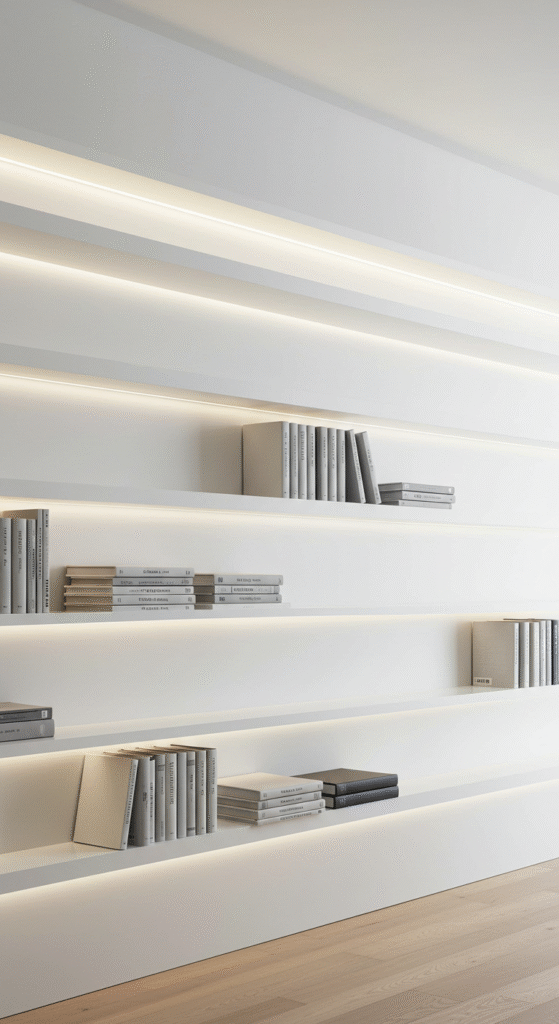
Push the boundaries of minimalist design with ultra-thin floating shelves that seem to disappear into the wall, creating the illusion that your books are magically suspended in mid-air. This dramatic effect is achieved through specially designed brackets that remain completely hidden.
These shelves work best when styled with books of similar heights and colors, creating clean horizontal lines that emphasize the “floating” effect. Intersperse books with small sculptures or plants in matching planters to maintain the illusion while adding visual interest.
This design approach is perfect for modern spaces where you want maximum impact with minimal visual weight. The clean lines and seemingly gravity-defying display create a conversation piece while serving the practical purpose of book storage.
6. Zen Garden Bookshelf
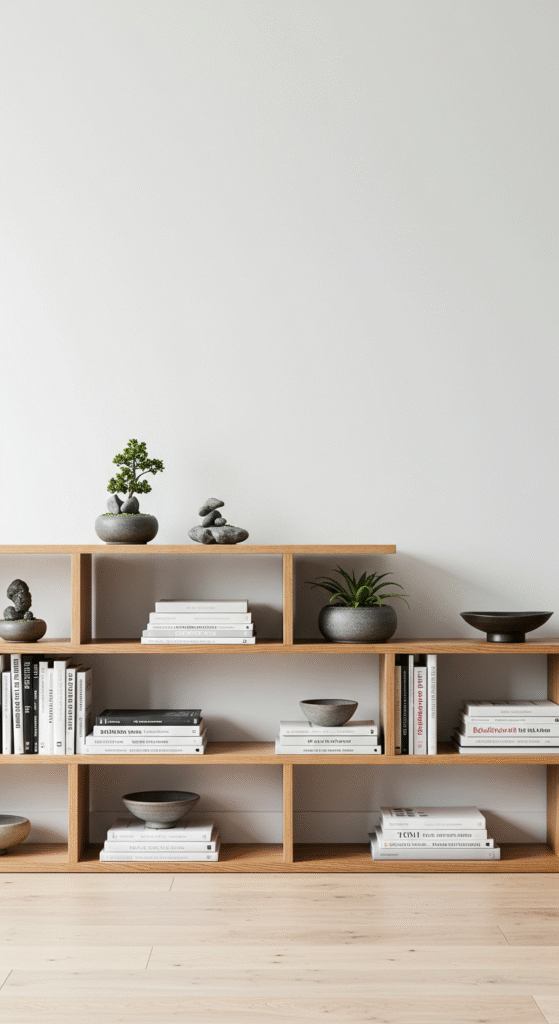
Bring tranquility to your space with a low, horizontal bookcase that incorporates principles of Japanese design and the calming aesthetics of zen gardens. Choose a piece with clean, rectangular lines in natural wood or white lacquer.
Style with careful attention to balance and negative space—group books in small clusters separated by meaningful objects like smooth stones, small zen gardens, or simple ceramic pieces. The horizontal emphasis creates a sense of groundedness and stability, while the careful spacing between objects allows each element to be appreciated individually.
This approach works beautifully in bedrooms or meditation spaces where you want to promote calm and reflection. The low profile doesn’t overwhelm the space, while the zen-inspired styling creates a sense of peaceful order.
7. Geometric Grid System
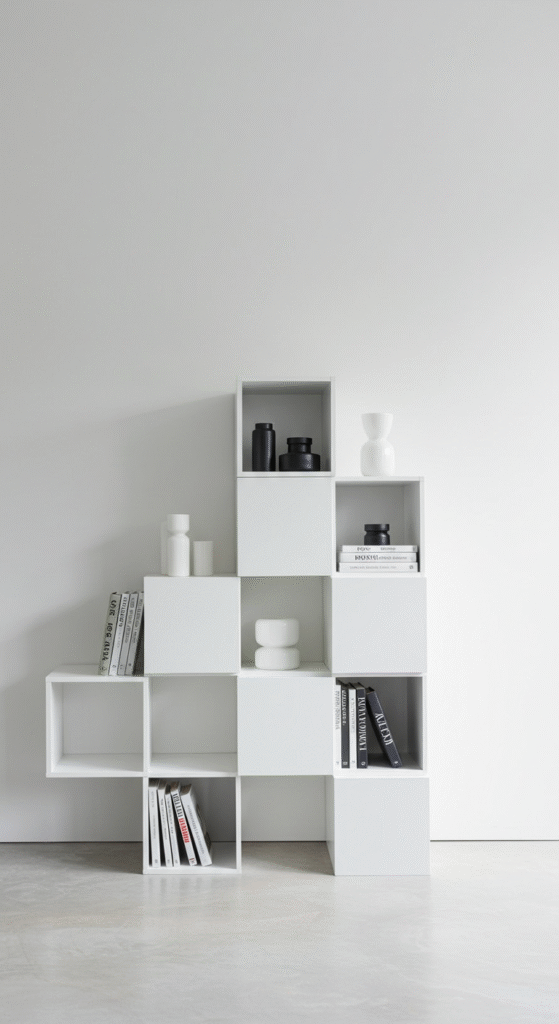
Create visual drama with a modular shelving system that forms perfect geometric patterns on your wall. Choose cube or rectangular modules that can be arranged in various configurations—perhaps a perfect square grid or an offset pattern that creates subtle visual movement.
The beauty of this system lies in its flexibility and mathematical precision. Each cube can be styled differently while contributing to the overall geometric composition. Some cubes might hold books, others decorative objects, and some might remain empty to emphasize the grid pattern and create breathing room in the design.
This approach appeals to lovers of modern architecture and geometric design, creating a focal point that’s both functional and artistic. The modular nature means you can easily reconfigure the arrangement as your collection grows or your aesthetic preferences evolve.
8. Minimalist Library Wall
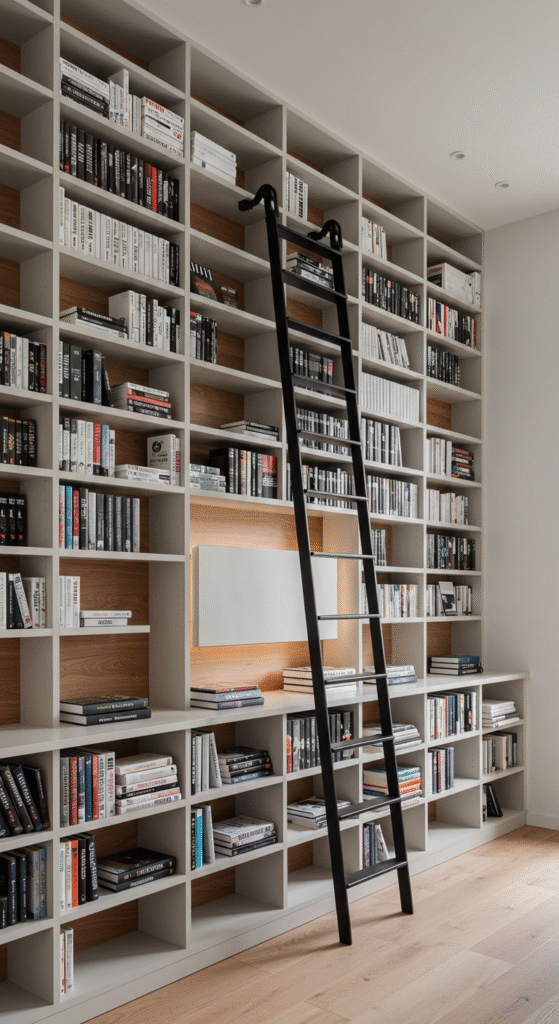
Transform an entire wall into a stunning library feature with floor-to-ceiling built-in shelves that emphasize clean lines and consistent proportions. This approach requires careful planning but creates maximum impact with its impressive scale and architectural presence.
The key to maintaining minimalist aesthetics at this scale is restraint in styling. Use consistent spacing between books, incorporate horizontal stacking for visual variety, and select books with complementary cover colors. Add a few carefully chosen decorative objects—perhaps a single piece of pottery per shelf or small plants at regular intervals.
Include a rolling ladder or stylish step stool to access higher shelves, which adds both functionality and visual interest to the design. This approach works best in spaces with high ceilings where the full impact of the floor-to-ceiling design can be appreciated.
9. Floating Corner Installation
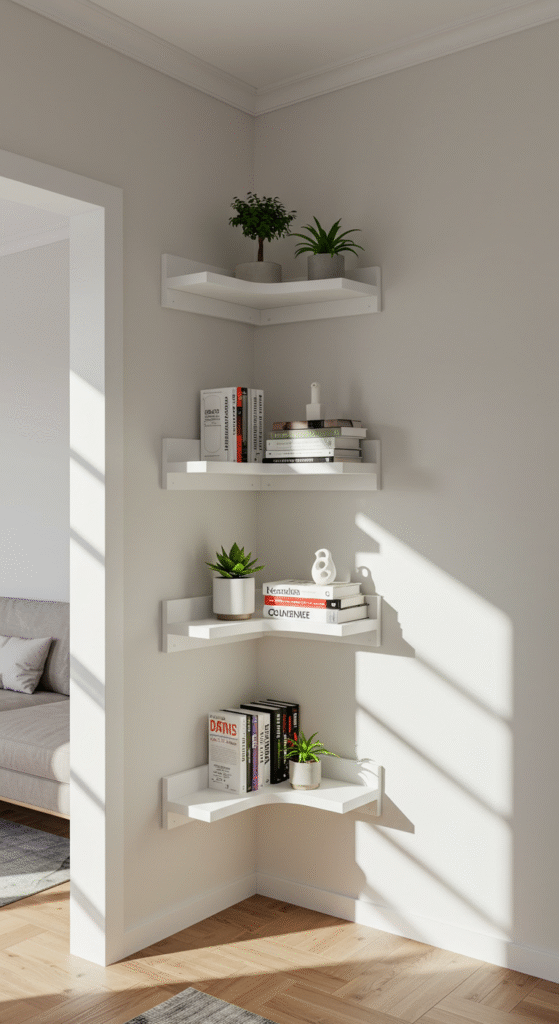
Make use of often-overlooked corner spaces with a series of floating shelves that wrap around the corner, creating a sculptural installation that maximizes storage in a small footprint. This design approach turns a corner into a focal point while maintaining the clean aesthetics of minimalist design.
Arrange shelves at varying heights and depths to create visual rhythm and accommodate books of different sizes. The wraparound design creates interesting sightlines from different angles in the room, making the corner feel integrated into the larger space rather than forgotten.
Style with books, small plants, and carefully chosen objects that look good from multiple viewpoints. This approach works particularly well in small apartments where every inch of space needs to work hard while still looking effortlessly elegant.
10. Industrial Minimal Pipe Shelving
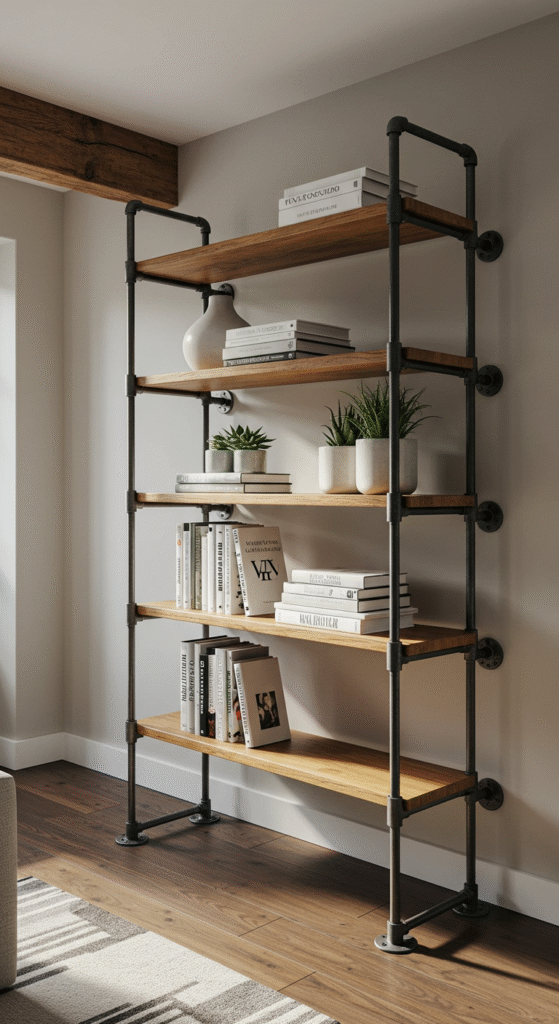
Combine the raw appeal of industrial design with minimalist sensibilities using a shelving system built from sleek metal pipes and wooden or glass shelves. The framework should be simple and geometric, allowing the materials themselves to provide visual interest.
Choose materials thoughtfully—matte black pipes with warm wood shelves create a sophisticated contrast, while chrome pipes with glass shelves maintain an airier feeling. The industrial framework provides structure and visual weight, while the minimalist styling keeps the overall effect clean and uncluttered.
This style works particularly well in loft spaces, modern apartments, or home offices where you want to add personality without sacrificing the clean aesthetic that defines minimalist design. The combination of materials adds texture and interest while maintaining functional efficiency.
11. Asymmetrical Balance Display
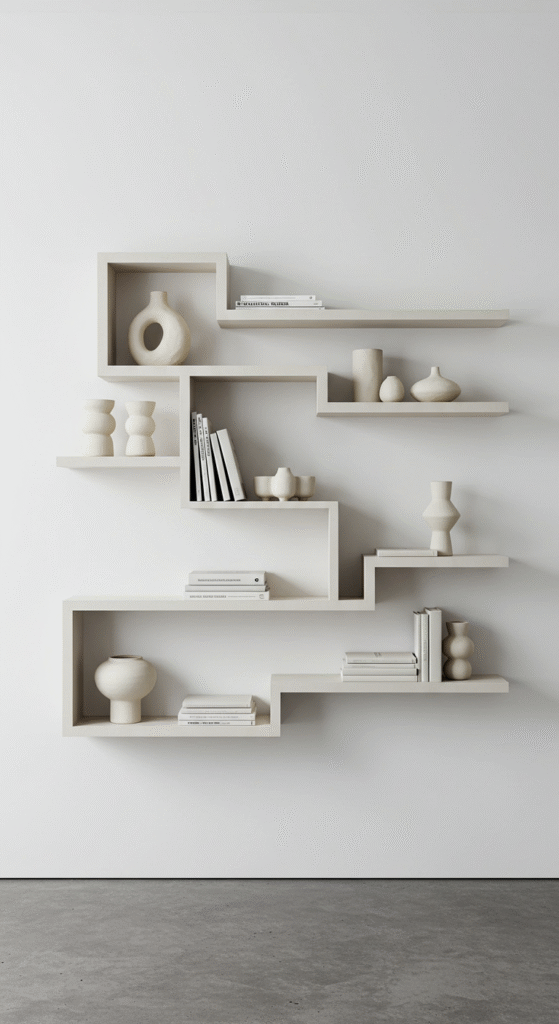
Create visual interest through carefully planned asymmetry that maintains overall balance while avoiding the predictable symmetry that can make minimalist spaces feel sterile. This approach requires a good eye for proportion and weight distribution.
Design your shelving arrangement with different sized elements that balance each other across the visual field. A large shelf on one side might be balanced by two smaller shelves on the other, or a heavily styled shelf might be balanced by one with more negative space.
The key is achieving visual equilibrium without perfect symmetry—this creates a more dynamic and interesting display while maintaining the calm, uncluttered feeling essential to minimalist design. This approach works well for creative personalities who want minimalist calm without rigid formality.
12. Monochrome Magic Setup
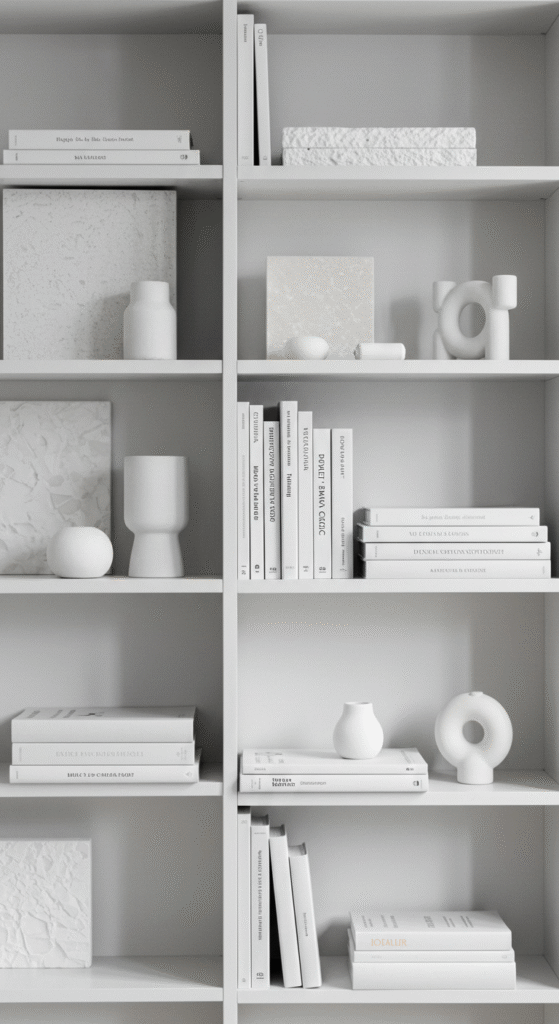
Create sophisticated drama by limiting your color palette to various shades of a single color—perhaps all whites and creams, or various grays from light to charcoal. This monochromatic approach creates cohesion and calm while allowing subtle variations in texture and shade to provide visual interest.
Choose books, decorative objects, and even plant pots in your chosen color family. The lack of color contrast forces attention to form, texture, and proportion—the fundamental elements of good minimalist design. Small variations in shade and texture become more noticeable and appreciated.
This approach creates a sophisticated, gallery-like feeling that works beautifully in formal spaces or bedrooms where you want to promote calm and rest. The monochromatic palette makes spaces feel larger and more unified while creating an Instagram-worthy backdrop for your daily life.
13. Nature-Inspired Organic Shelving
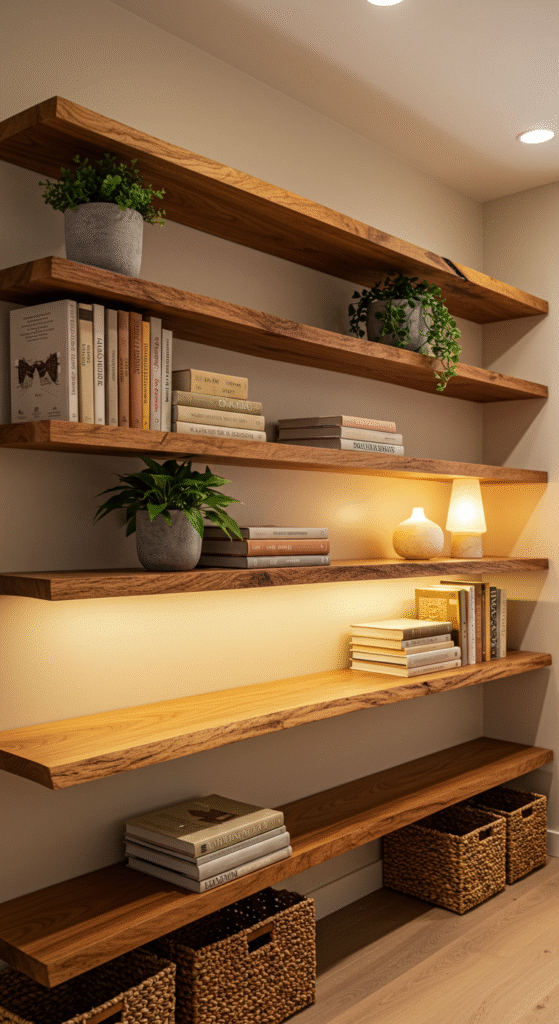
Bring the calming influence of nature indoors with shelving that incorporates organic shapes and natural materials. Think live-edge wood shelves with their natural curves, or metal brackets that mimic tree branches while maintaining clean, minimalist lines.
The organic elements should be subtle—perhaps the gentle curve of a natural wood edge or the way metal brackets create flowing lines reminiscent of plant forms. Complement these natural elements with books and objects in earth tones, and incorporate living plants to strengthen the connection to nature.
This approach creates a minimalist space that feels warm and alive rather than stark or cold. The natural elements provide visual interest and textural variety while maintaining the uncluttered aesthetic that defines minimalist design.
14. Illuminated Accent Shelving
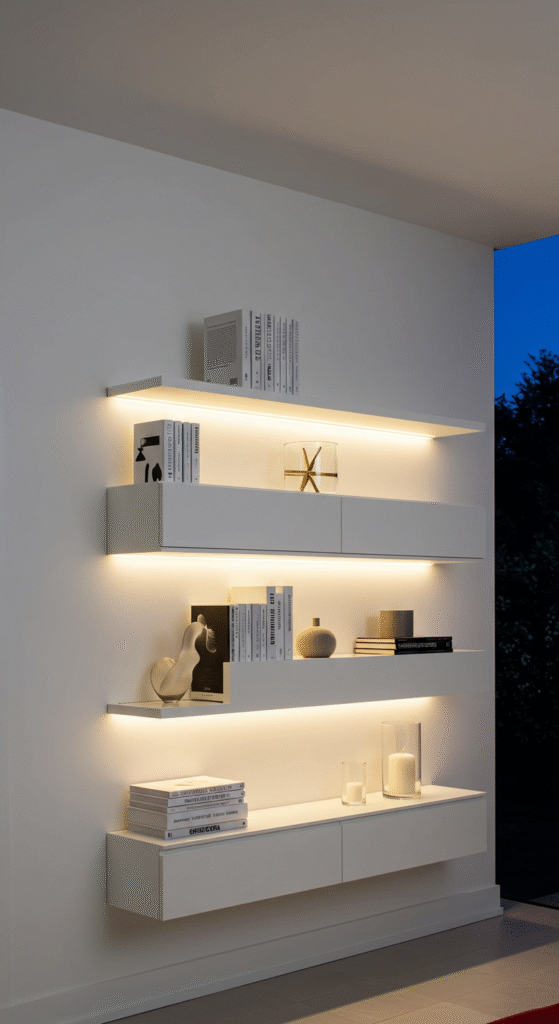
Add drama and functionality with integrated LED lighting that transforms your bookshelf into a glowing architectural feature. The lighting should be subtle and evenly distributed—think thin LED strips hidden along shelf edges or soft backlighting that creates a halo effect.
The illumination serves both practical and aesthetic purposes, making it easier to find books while creating beautiful ambient lighting for the room. Choose warm white LEDs for a cozy feeling or cool white for a more modern, architectural effect.
This approach works particularly well in spaces where the bookshelf needs to serve as both storage and ambient lighting. The glow creates visual hierarchy and makes the bookshelf a focal point even when lights are dimmed for evening relaxation.
15. Sculptural Statement Piece
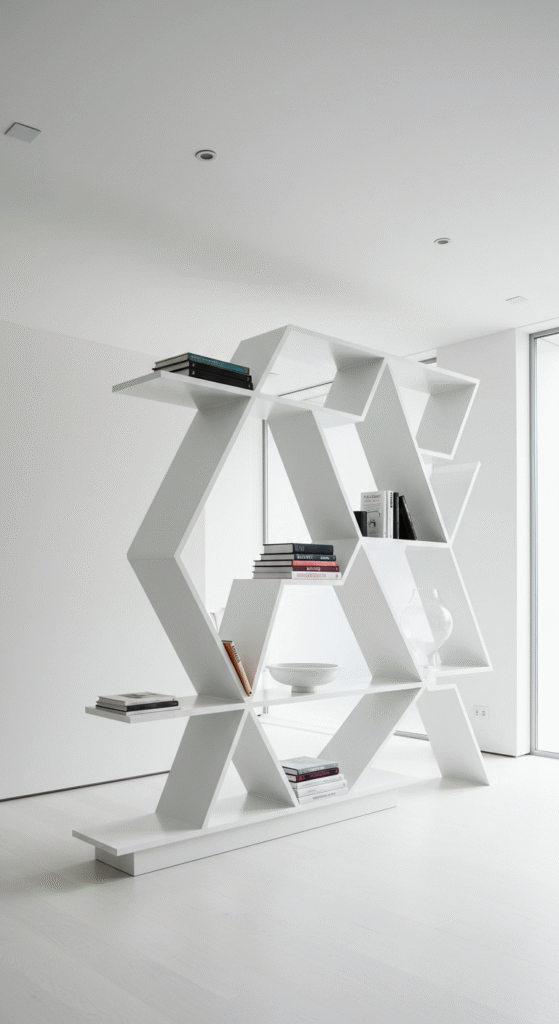
End with impact by choosing a bookshelf that functions as both storage and sculpture. This might be a uniquely shaped piece with interesting angles, or a traditional shape executed in an unexpected material like concrete, metal, or mixed media.
The sculptural element should be the primary feature, with styling kept deliberately simple to let the form speak for itself. Choose books and objects that complement rather than compete with the shelf’s unique design, using the principles of minimalist styling to create harmony between form and function.
This approach works best when you have a specific space that needs a statement piece—perhaps a large empty wall or a corner that lacks visual interest. The sculptural shelf becomes the room’s focal point while providing practical storage and maintaining minimalist principles.
Final Styling Tips for Pinterest-Perfect Results
Color Coordination: Keep book spines in a cohesive color palette—neutrals, earth tones, or a carefully curated selection of complementary colors.
The Rule of Thirds: When styling shelves, divide the visual space into thirds and vary the arrangement to create pleasing proportions.
Negative Space: Remember that empty space is just as important as filled space in minimalist design. Don’t feel compelled to fill every inch.
Height Variation: Mix books stored vertically and horizontally, and vary the heights of decorative objects to create visual rhythm.
Personal Touch: Include a few meaningful objects that reflect your personality while maintaining the overall minimalist aesthetic.
Lighting Matters: Ensure your bookshelf area has good lighting to showcase your careful styling and create an inviting atmosphere for reading.
These 15 minimalist bookshelf ideas prove that functional storage can be beautiful, calming, and perfectly suited to modern living. Whether you choose one approach or combine elements from several, remember that the best minimalist design reflects your personal style while maintaining the clean, intentional aesthetic that makes spaces feel like home.
Save this post for your next home design project and follow for more minimalist decorating inspiration that transforms spaces into serene sanctuaries.
